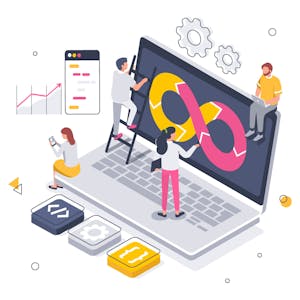Continuous Integration and Continuous Delivery (CI/CD)
A principle of DevOps is to replace manual processes with automation to improve efficiency, reduce human error, and accelerate software delivery. This requires automation that continuously integrates code changes and continuously delivers those changes to a production environment. This course introduces you to Continuous Integration and Continuous Delivery (CI/CD), an automated approach to software development. You’ll discover the benefits of CI/CD for creating a DevOps pipeline and explore popular CI/CD tools.
You’ll examine the key features of CI, explore social coding, and the Git Feature Branch Workflow. You will also learn about standard CI tools and gain a deep understanding of GitHub Actions workflows and their components.
This course provides an overview of CD and its goals, benefits, and best practices. You will learn the requirements of a CI/CD pipeline and discover standard CD tools.
You will explore Tekton and discover how its components work together to create a CD pipeline. You will learn how to build a pipeline, pass parameters to a pipeline, build triggers to start pipeline runs, implement reusable tasks, and create custom tasks. You will discover how to complete your CD pipeline by building a container image and deploying your application to an OpenShift Kubernetes cluster.
Throughout the course, you can hone your skills and challenge yourself through several hands-on labs.
Explain Infrastructure as Code, describe tools used, and create Infrastructure as Code scripts using Terraform.
Describe cloud platforms and automation, and automatic CI/CD tasks using Jenkins and GitHub.
Define Continuous Integration (CI) and list some examples of tools used for CI.
Describe the process of Continuous Development (CD), run test cases, and deploy to cloud using tools including Chef and Puppet.
Syllabus
Syllabus - What you will learn from this course
Week 1
Introduction to CI/CD
Week 2
Continuous Integration (CI)
Week 3
Continuous Delivery (CD)
Week 4
Final Exam
FAQ
When will I have access to the lectures and assignments?
Access to lectures and assignments depends on your type of enrollment. If you take a course in audit mode, you will be able to see most course materials for free. To access graded assignments and to earn a Certificate, you will need to purchase the Certificate experience, during or after your audit. If you don't see the audit option:
The course may not offer an audit option. You can try a Free Trial instead, or apply for Financial Aid.
The course may offer 'Full Course, No Certificate' instead. This option lets you see all course materials, submit required assessments, and get a final grade. This also means that you will not be able to purchase a Certificate experience.
What will I get if I subscribe to this Certificate?
When you enroll in the course, you get access to all of the courses in the Certificate, and you earn a certificate when you complete the work. Your electronic Certificate will be added to your Accomplishments page - from there, you can print your Certificate or add it to your LinkedIn profile. If you only want to read and view the course content, you can audit the course for free.
Do I need to know anything about DevOps to take this course?
Yes, knowledge of basic DevOps principles is required. Additionally, the following skills are required:
-IT and Cloud Computing Fundamentals
-Containers and Kubernetes Fundamentals
-Python
-Linux Commands
-Git/GitHub
Which software tools are required?
You are not required to download or install any tools on your device. However, you will need to sign up and use no-charge GitHub account and use other no-charge tools from IBM and OpenSource in your browser.
Reviews
from zero to hero. Learning the basics principles and practicals of continous integration and delivery. I would encourage anyone who want to learcn CI CD to take this course.
